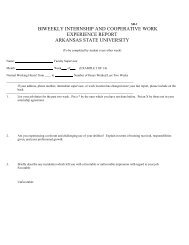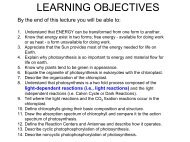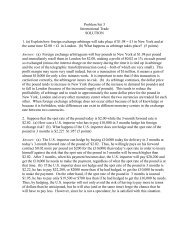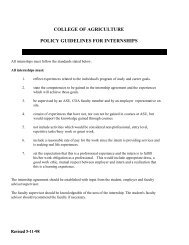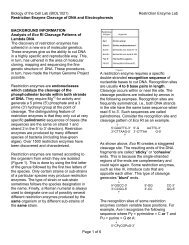Chapter 6 Skin and the Integumentary System - Arkansas State ...
Chapter 6 Skin and the Integumentary System - Arkansas State ...
Chapter 6 Skin and the Integumentary System - Arkansas State ...
Create successful ePaper yourself
Turn your PDF publications into a flip-book with our unique Google optimized e-Paper software.
<strong>Chapter</strong> 6<br />
<strong>Skin</strong> <strong>and</strong> <strong>the</strong> <strong>Integumentary</strong><br />
<strong>System</strong><br />
• Composed of several tissues<br />
• Maintains homeostasis<br />
• Protective covering<br />
• Retards water loss<br />
• Regulates body temperature<br />
• Houses sensory receptors<br />
• Contains immune system cells<br />
• Syn<strong>the</strong>sizes chemicals,<br />
including Vitamin D<br />
• Excretes small amounts of<br />
waste
• Epidermis<br />
• Dermis<br />
• Subcutaneous layer<br />
Layers of <strong>Skin</strong>
Epidermis, Dermis, & Basement Membrane<br />
• Epidermis is subdivided into layers of stratified<br />
squamous epi<strong>the</strong>lium<br />
• Dermis is made up of connective tissue, epi<strong>the</strong>lial tissue,<br />
smooth muscle tissue, nervous tissue, <strong>and</strong> blood.<br />
• Basement membrane is anchored to <strong>the</strong> dermis by short<br />
fibrils <strong>and</strong> separates <strong>the</strong>se two layers of skin
Epidermis<br />
• lacks blood vessels<br />
• keratinized<br />
• thickest on palms <strong>and</strong> soles (0.8-1.4mm)<br />
• melanocytes provide melanin<br />
• rests on basement membrane<br />
• stratified squamous
Layers of Epidermis<br />
• stratum corneum<br />
• stratum lucidum<br />
• stratum granulosum<br />
• stratum spinosum<br />
• stratum basale<br />
Epidermis
Layers of <strong>the</strong> Epidermis
<strong>Skin</strong> Changes: Rashes
Chicken Pox<br />
Shingles<br />
Lyme Disease<br />
Impetigo
Melanocytes <strong>and</strong> Pigment Granules
All people have <strong>the</strong> same number of<br />
melanocytes in <strong>the</strong>ir skin
Albinism: Lack of Melanin
Paul Bettany in Columbia Pictures' The<br />
Da Vinci Code - 2005<br />
THE ALBINO MONK?
Dermis<br />
• on average 1.0-2.0mm thick<br />
• dermal papillae<br />
• binds epidermis to underlying<br />
tissues<br />
• irregular dense connective tissue<br />
• muscle cells<br />
• nerve cell processes<br />
• blood vessels<br />
• hair follicles<br />
• gl<strong>and</strong>s
Subcutaneous Layer<br />
• hypodermis<br />
• loose connective tissue<br />
• adipose tissue<br />
• insulates<br />
• major blood vessels
Hair Follicles<br />
• epidermal cells<br />
• tube-like depression<br />
• extends into dermis<br />
• hair root<br />
• hair shaft<br />
• hair papilla<br />
• dead epidermal cells<br />
• melanin<br />
• arrector pili muscle
Grey’s s Anatomy<br />
With age, a<br />
loss of<br />
melanin in hair<br />
can lead to<br />
grayness.<br />
EXAMPLES<br />
OF HAIR<br />
COLOR<br />
VARIATION<br />
Red Heads<br />
have iron<br />
pigment<br />
(trichosiderin)<br />
Everyone<br />
except albinos<br />
have various<br />
amounts of<br />
melanin in<br />
<strong>the</strong>ir hair.
Nails<br />
• protective coverings<br />
• nail plate<br />
• nail bed<br />
• lunula<br />
6-9
Sebaceous Gl<strong>and</strong>s<br />
• usually associated with hair<br />
follicles<br />
• holocrine gl<strong>and</strong>s –<br />
disintegrating cell <strong>and</strong> its<br />
contents for <strong>the</strong> secretion<br />
• secrete sebum<br />
• absent on palms <strong>and</strong> soles
Sweat or Sudoriferous Gl<strong>and</strong>s<br />
• widespread in skin<br />
• deeper dermis or hypodermis<br />
• eccrine gl<strong>and</strong>s – types of<br />
merocrine gl<strong>and</strong> that secrete fluid<br />
(sweat) product released through<br />
<strong>the</strong> cell membrane<br />
• aprocrine sweat, ceruminous<br />
(wax), & mammary (milk)<br />
gl<strong>and</strong>s – types of aporocrine<br />
gl<strong>and</strong>s that secrete cellular<br />
product <strong>and</strong> portion of <strong>the</strong> free<br />
ends of cells
Regulation of Body<br />
Temperature
Problems in Temperature<br />
Regulation<br />
Hyper<strong>the</strong>rmia – abnormally high body temperature<br />
Human Body<br />
Temperature = 37 o C<br />
or 98.6 o F.<br />
Hypo<strong>the</strong>rmia – abnormally low body temperature
<strong>Skin</strong> Color<br />
Genetic Factors<br />
• varying amounts of<br />
melanin<br />
• varying size of melanin<br />
granules<br />
• albinos lack melanin<br />
Environmental Factors<br />
• sunlight<br />
• UV light from sunlamps<br />
• X rays<br />
Physiological Factors<br />
• dilation of dermal blood<br />
vessels<br />
• constriction of dermal blood<br />
vessels<br />
• carotene<br />
• jaundice<br />
George Hamilton – sun<br />
worshiper?
The Tan Man at The University of Kansas<br />
http://www2.ljworld.com/news/2006/may/03/hes_still<br />
_tan_after_all_<strong>the</strong>se_years/?city_local
Healing of Cuts
Healing of Burns<br />
First degree burn – superficial partial-thickness<br />
(epidermis damaged)<br />
Second degree burn – deep partial-thickness (epidermis<br />
& dermis damaged)<br />
Third degree burn – full-thickness (epidermis, dermis,<br />
& accessory skin structures)<br />
• autograft (self-transplant)<br />
• homograft (temporary transplant from donor)<br />
• various skin substitutes<br />
• extensive scars
Rule of Nines
Life Span Changes<br />
• Scaly skin<br />
• Age spots<br />
• Dermis becomes reduced<br />
• Loss of fat<br />
• Wrinkles<br />
• Sagging<br />
• Sebaceous gl<strong>and</strong>s secrete<br />
less oil<br />
• Melanin production slows<br />
• Hair thins<br />
• Number of hair follicles<br />
decrease<br />
• Impaired nail growth<br />
• Sensory receptors decline<br />
• Inability to control body<br />
temperature<br />
• Less vitamin D production
Life Span Changes - <strong>Skin</strong>
Clinical Application<br />
Acne Vulgaris<br />
• most common skin disorder<br />
• sebum <strong>and</strong> epi<strong>the</strong>lial cells clog gl<strong>and</strong>s<br />
• produces whiteheads <strong>and</strong> blackheads (comedones)<br />
• anaerobic bacteria trigger inflammation (pimple)<br />
• largely hormonally induced<br />
• <strong>and</strong>rogens stimulate sebum production<br />
• treatments include antibiotics, topical creams, birth control pills
Common <strong>Skin</strong> Disorders<br />
• Athlete’s s foot – tinea pedis or ringworm fungal infection of <strong>the</strong> foot.<br />
• Birthmark – congenital blemish or spot on <strong>the</strong> skin.<br />
• Boil – bacterial infection of <strong>the</strong> skin produced when bacteria enter a hair<br />
follicle.<br />
• Carbucnle – bacterial infection, similar to a boil, that spreads into <strong>the</strong><br />
subcutaneous tissues.<br />
• Cyst – fluid-filled filled capsule.<br />
• Eczema – noncontagious skin rash.<br />
• Ery<strong>the</strong>ma – reddening of <strong>the</strong> skin due to dilation of dermal blood vessels in i<br />
response to injury or inflammation.<br />
• Herpes– characterize by a recurring formations of small clusters of vesicles;<br />
usually caused by herpes simplex virus; contagious.<br />
• Keloid – elevated enlarging fibrous scar usually initiated by an injury.<br />
• Mole – fleshy skin tumor that is usually pigmented.<br />
• Pediculosis – disease produced by an infestation of lice.<br />
• Pruritus – itching of <strong>the</strong> skin.<br />
• Pusule – elevated, pus-filled area.
Xeroderma Pigmentosum<br />
• Extreme freckling <strong>and</strong> skin<br />
cancer due to lack of DNA<br />
repair enzymes.
Types of <strong>Skin</strong> Cancer<br />
Squamous cell<br />
carcinoma –<br />
derived from<br />
epi<strong>the</strong>lial tissue<br />
Basal cell<br />
carcinoma –<br />
derived from<br />
epi<strong>the</strong>lial tissue<br />
Malignant<br />
melanoma –<br />
derived from<br />
melanocytes



